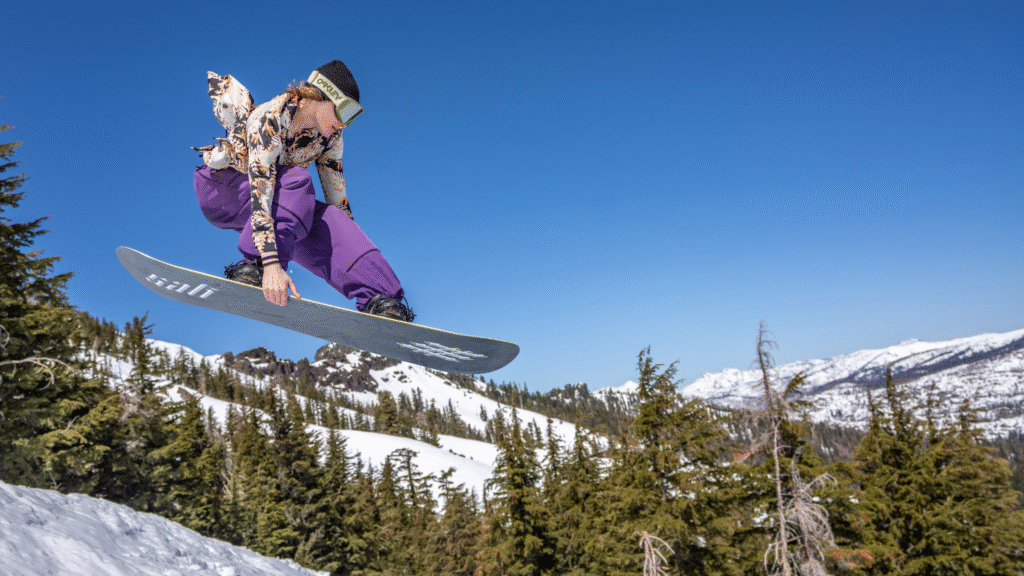Updated October 21, 2025 11:28AM
When putting together your snowboard kit, no piece of the puzzle is more critical than your boots. The best snowboard boots don’t just connect your body to your board; they’re also the key to on-hill comfort. The wrong boots can cause hot spots, blisters, heel lift, toe bang, or swamp foot—all potential day-ruiners. The right boots, however, can make previously torturous bell-to-bell days no big deal. Not to mention, they can significantly improve your performance on the slopes.
To help point you toward the right pair, we tested 24 boots for the 2025/2025 season during our annual snowboard test, which went down this past spring at Kirkwood Mountain Resort (and beyond). We cross-referenced tester favorites from this year with top models from previous years before putting together this guide to the best snowboard boots. No matter if you’re an all-mountain freestyler or a hard-charging freerider, chances are you’ll find a good fit for you below.
At a Glance
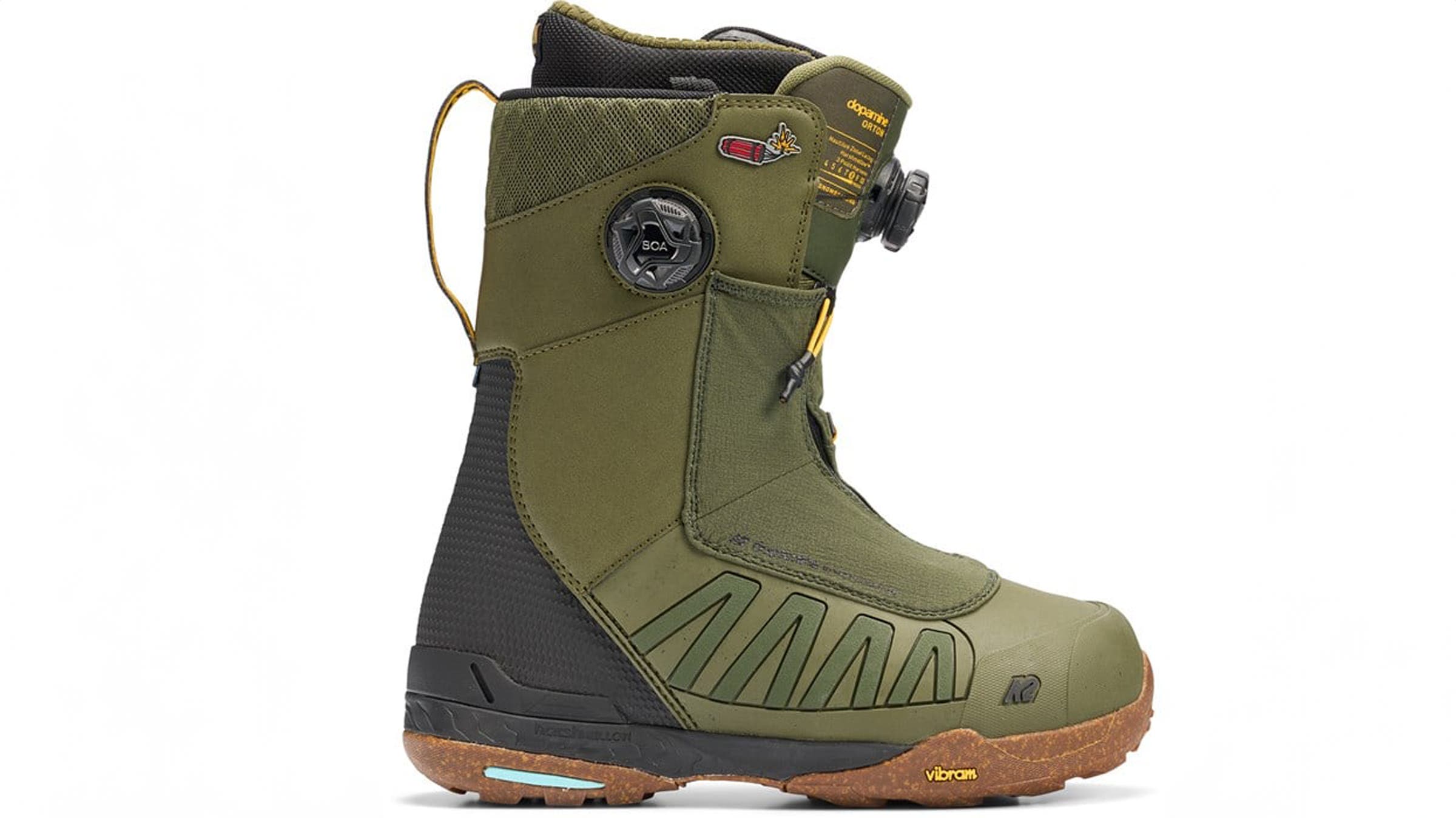
Best All-Mountain Men’s Boot
K2 Orton
Sizes: 7-13 (men’s)
Pros and Cons
+ Lightweight and minimalist footprint
+ Aggressive all-mountain ride
+ Responsive yet tweakable
+ Good tread
– Requires break-in period
Built for full-throttle, all-mountain shredding and freeriding, the K2 Orton was our favorite mid-stiff-flexing, high-performance snowboard boot of the test. For such a slim silhouette, these boots offer an aggressive flex that one tester loved for the instantaneous power transfer in and out of turns.
A sturdy ENDO 2.0 backstay gives the Orton a responsive, reliable backbone, while K2’s chatter-dampening, impact-absorbing Eco-Harshmellow Pro insoles make the boots ideal for “big drops and faster riding,” according to a Tahoe snowboard coach. He loved the lacing, too: a combination of fine-tunable double Zonal BOA Fit System dials with a velcro-cuffed liner. He reported, “No heel lift. The liner felt structured and supportive while keeping my foot locked in.” He gave additional kudos to the bootpacking-ready Vibram V5 outsole, which offered “high-quality” tread and traction.
We found the toebox laterally spacious for a variety of foot shapes, but our tester reported that a multi-day break-in period was necessary for max performance. As such, he warned: “This is not an entry-level boot.” But for charging riders who love to ride anything and everything? He summed it up as an “all-mountain rider’s dream boot.”
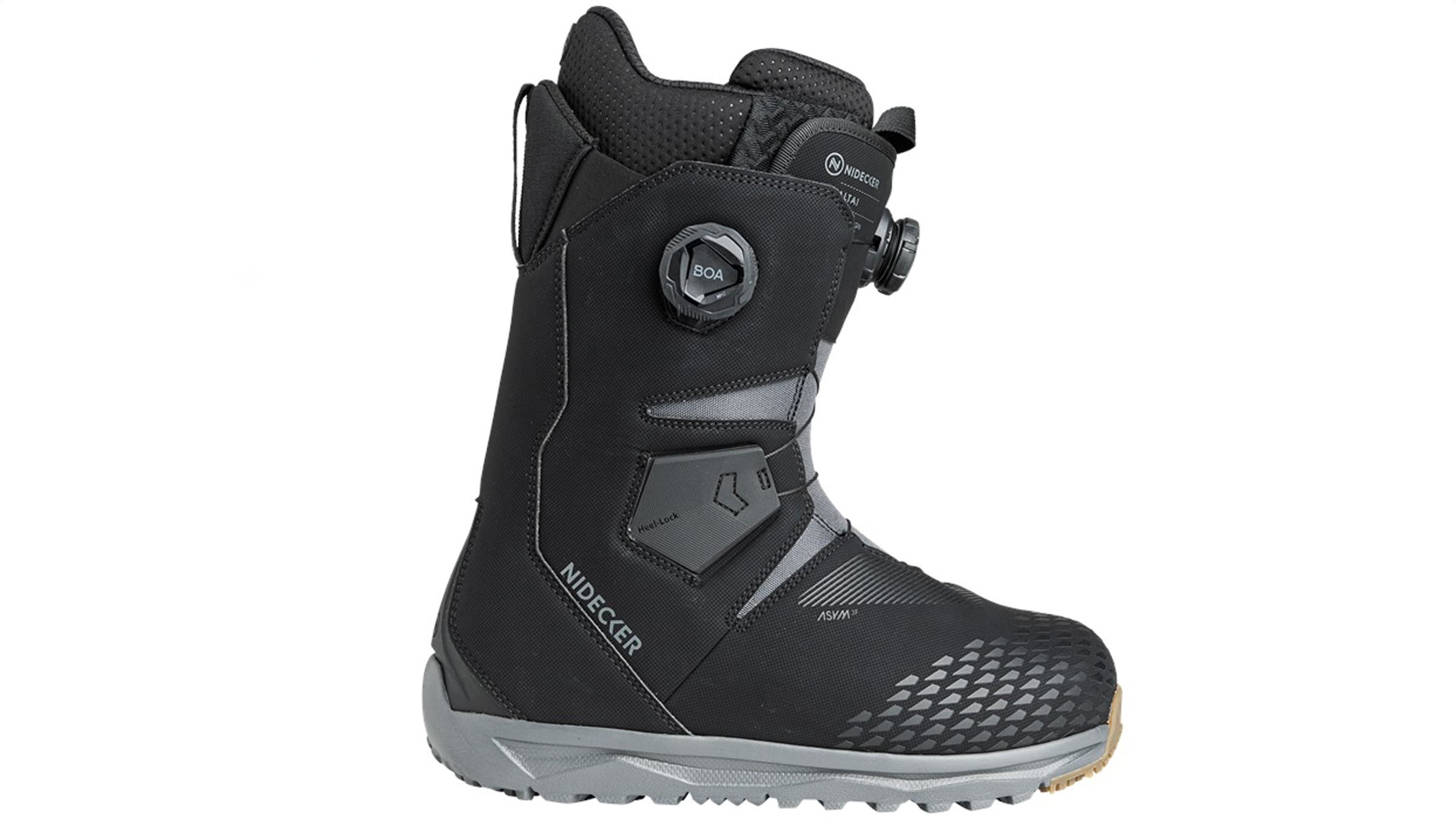
Best Value
Nidecker Altai (Unisex)
Sizes: 7-14 (men’s); 5.5-10 (women’s)
Pros and Cons
+ Comfy out of the box
+ Lightweight
+ Good shock absorption
– Flimsy insoles
– Durability concerns around the foam outsole
– Doesn’t work well with FASE bindings
The lightweight, affordable, and medium-flexing Nidecker Altai also happened to be one of the top rated snowboard boots in the comfort department. An Eastern Sierra tester with a history of foot pain was impressed by the coziness from lap one. “I haven’t had these professionally fit, and they are remarkably comfortable out of the box,” she reported, shouting out the plush, foot-hugging liner and the roominess of the 3D-molded toe box.
After replacing the “flimsy” stock insoles with custom footbeds, a Tahoe snowboard instructor called the Altai “perfect for everyday riding” thanks to “a blend of comfort and responsive mid-flex.” She co-signed the double-BOA lacing and velcro-cuffed liner that stayed tight and secure. The asymmetrically designed closure, which shifts BOA lacing inwards and over the flattest zone of the forefoot, is a hallmark of Nidecker’s boot line, and the Swiss outfitter claims it reduces pressure and discomfort. Our testers confirmed as much: “Stayed tight, no pressure points, super comfy,” said another rider.
By loosening the upper BOA, a freestyle-oriented rider could dip in and out of the park, boning tweaked grabs and buttering to his heart’s content. The lightweight, cushy foam outsole absorbed flat landings well, he reported, although multiple testers worried about the foam sole’s durability compared to harder-wearing rubber outsoles found on the pricier options in this guide. Additional dings? The lipped backstay doesn’t fit well with FASE bindings while unstrapping, and a couple of testers had to size up a half size.
Beyond that, our crew recommended the boot for lower intermediates to advanced riders, warning that newbies could benefit from a softer flex and hard-charging speed demons would crave more support.
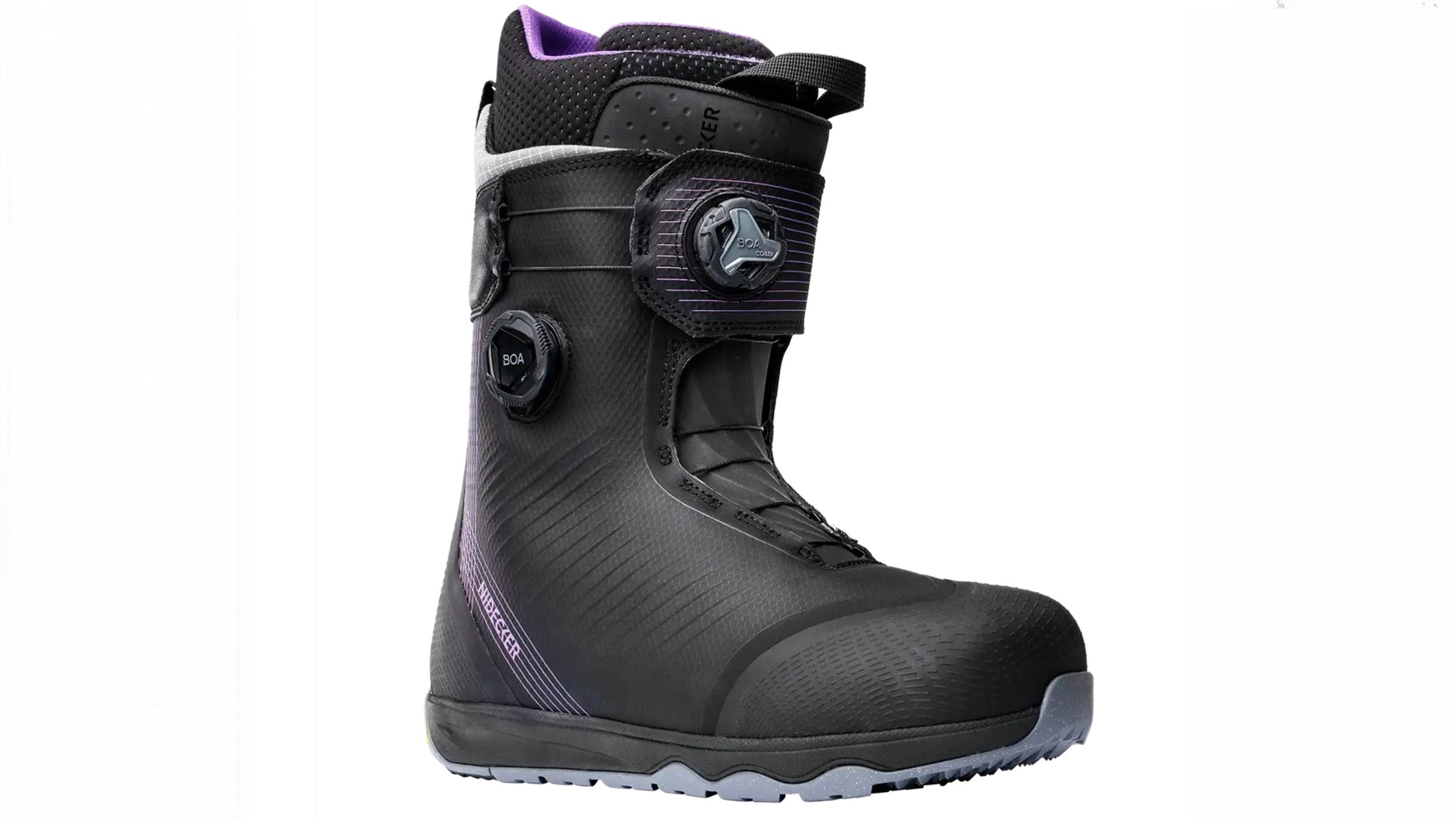
Best Freeride Men’s Boot
Nidecker Kita APX
Sizes: 7-13 (men’s)
Pros and Cons
+ Durable
+ Solid and trustworthy when bootpacking
+ Stiff and responsive for freeriding
+ Packed with premium tech and features
– Significant break-in required
– Stiffness is overkill for most riders
How stiff is the Nidecker Kita APX? “Bourbon on the rocks after a big day kinda stiff,” joked a hard-charging Tahoe tester who put the Kita APX to the test all spring long. That stiffness places it among the best snowboard boots for aggressive freeriders seeking maximum power and response. The Kita APX features a similar construction to Nidecker’s tester-approved Kita (also available in a women’s version, while the APX is only available in men’s). It features a steely, responsive backstay; a durable, step-kicking TPU armor around the toe; a wrapping, heat-moldable liner; and a rock-and-ice-ready Vibram outsole with integrated gel pockets for tempering flat drops and chunder. “That outsole is ready for ridge scrambles and backcountry bootpacks, and it can handle bigger cliffs than I can,” commented a backcountry and resort rider.
However, the pricier, elevated APX version features a BOA-tightened, power-strap-style cuff that cinches over the shin, delivering even more top-tier reactivity and instantaneous turning. Testers scored the boot highly in speed and responsiveness, and agreed it’s best for big lines and strong, powerful riding. However, one noted that the week-plus break-in process was substantial. But as someone who “rides 100+ days a year and trashes boots every season,” investing time in the APX, which he hypothesized would last more than his usual one-and-done winter, was well worth it. Lastly, he gave Nidecker props for keeping the silhouette slim and the package relatively lightweight for such a responsive and freeride-friendly boot.
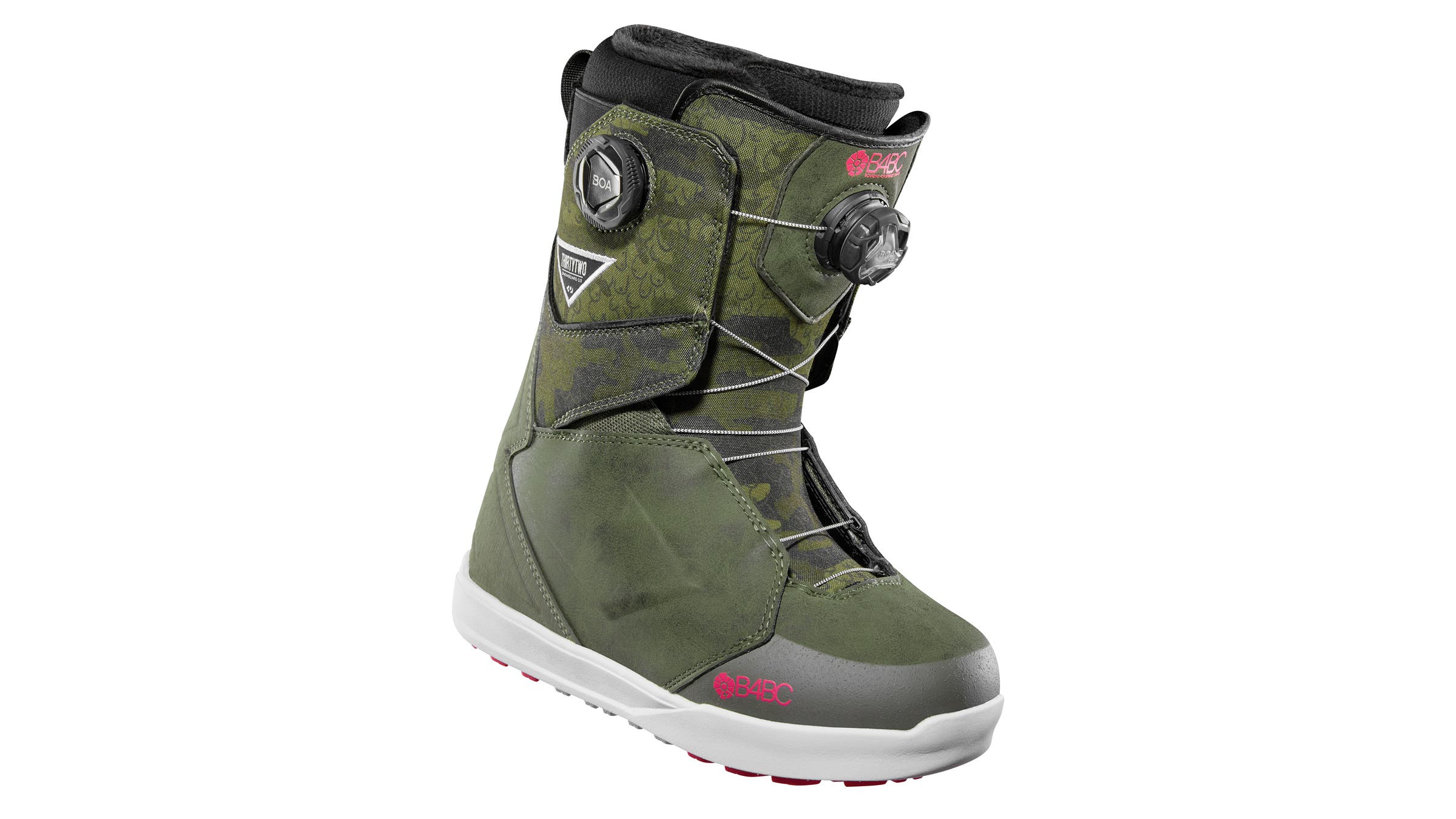
Best All-Mountain Freestyle Women’s Boot
ThirtyTwo Lashed Double BOA B4BC
Sizes: 5-10 (women’s)
Pros and Cons
+ B4BC collab colorway supports breast cancer nonprofit
+ Mid-soft freestyle flex
+ Improved liner
+ Included heel hold kit
– Comfort issues with toeside flexion
– Bulky
ThirtyTwo’s Lashed Double BOA is a boot our testers can get behind. A notch softer than the popular TM-2 ($210), it gives cruisy riders, all-mountain freestylers, and jibbers a playful, pliable flex and comfortable fit. For the 10th year running, ThirtyTwo and Boarding For Breast Cancer (B4BC) teamed up on a collab, dropping this limited-edition version of the Lashed Double BOA. A portion of proceeds from the forest green colorway will fund the nonprofit’s programming, which includes prevention and awareness events at ski resorts and wellness retreats for breast cancer survivors.
The boot itself is free of frills. It’s a standard dual-BOA boot, with an internal ankle harness that hugs a dual-density, heat-moldable ThirtyTwo Team liner. One tester quickly made use of ThirtyTwo’s included heel hold kit—a set of foam donuts that slip into integrated pockets on the boot liner to reinforce the ankle. “I experienced minimal heel lift,” she said. She also gave her stamp of approval to the updated Team liner.
If you’ve been popping glucosamine-like gummy vitamins, you’ll be stoked that the Lashed boasts a light yet robust rubber outsole with integrated foam cushioning for cartilage-sparing impact absorption. And while the freestyle-friendly lateral flex is apt for jibbing, pressing, buttering, airing, and tweaking, a stiffer backstay offers enough resistance and response from edge-to-edge for all-mountain missions far from the park. “I’m a freestyle, all-mountain rider, but I wouldn’t be afraid to use these freeriding, too,” offered our tester. She scored the boot high for both overall performance and responsiveness thanks to its combination of flex and features, giving a rare perfect score for comfort.
That said, testers weren’t without complaints. The Lashed is on the bulky side. One rider reported a midfoot pressure point where the boot buckled from toeside flexion, and she also noted that the profile was bulkier than previous years’ models.
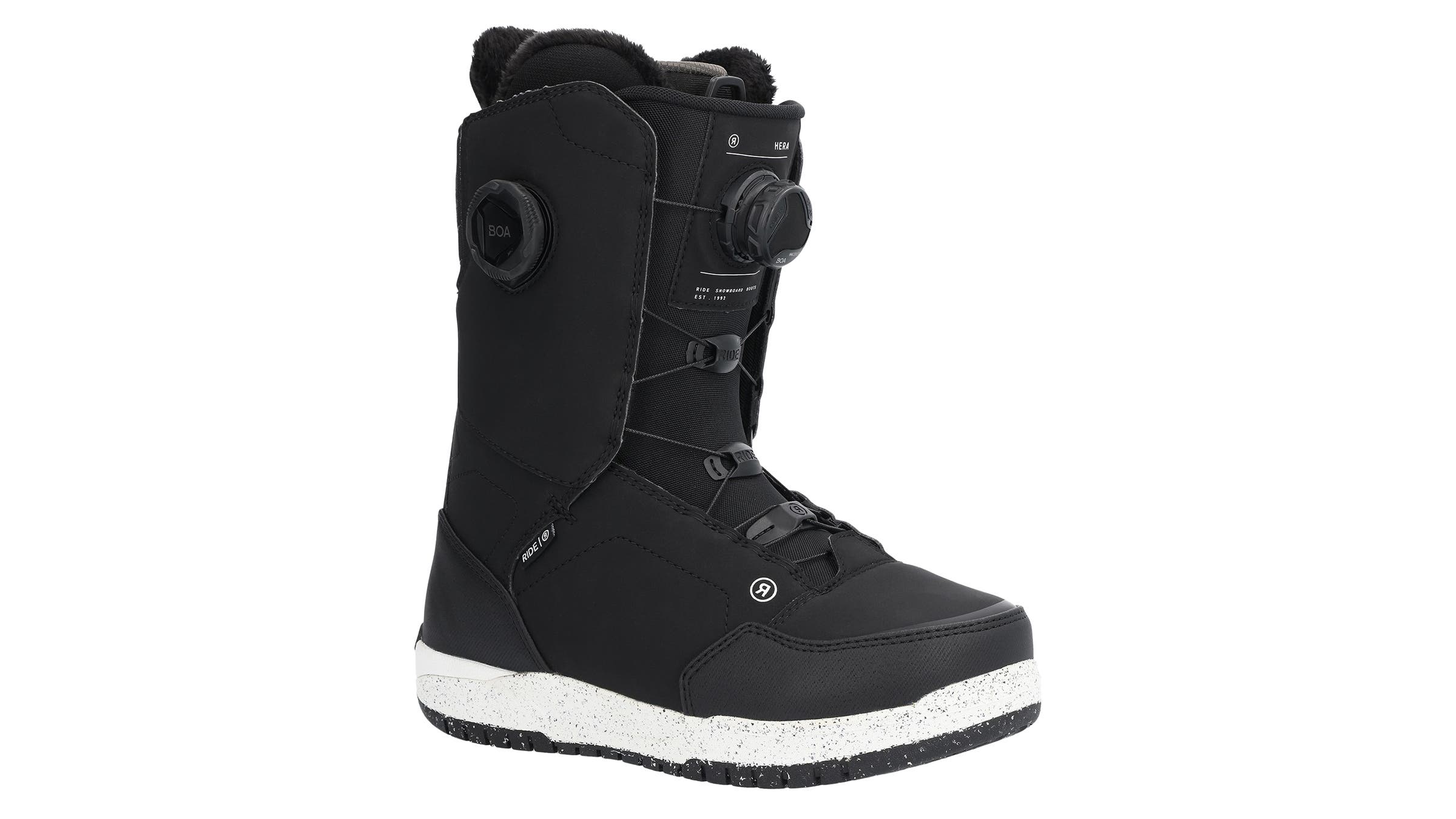
Best All-Mountain Intermediate Women’s Boot
Ride Hera
Sizes: 5-11 (women’s)
Pros and Cons
+ Approachable flex
+ Minimal footprint
+ Cushy, comfy construction and liner
+ Decent heel hold
– Singular outer BOA creates discomfort
Low-profile and well-cushioned with a mid-flex, the Ride Hera is a solid all-mountain option for intermediate and laidback advanced all-mountain riders. One tester would spend her own money to purchase a pair of the Ride Hera. A cruisy all-mountain rider from June Lake, California, with pain-prone feet (high-arch, narrow feet, and neuromas galore), she values comfort as much as she does the ability to ride everywhere from park to powder. Thanks to a mid flex, articulated cuff, cushy Intuition liner, and impact-absorbing foam midsole underfoot, the Hera ticks both boxes, leading Taylor to recommend the option for fellow “all-mountain riders who like to do a little jibbing and a little freeriding.”
Testers were blown away by the Hera’s minimal footprint, reporting, “They’re so low profile and pretty light, I actually had to adjust the straps on my bindings to get them tight enough over the boots.” We also appreciated Ride’s women’s-specific calf adjustment system, consisting of velcro pull tabs that allow riders to tighten or expand the rear cuff of the boot to best suit your individual body type.
The Hera scored well for its internal H4 BOA coiler that wraps the ankle tight, providing solid fit and responsiveness. However, multiple testers said they wished the outer BOA was redesigned. As is, one BOA dial controls the entire outer lacing system, and testers missed the ability to tighten the upper and lower separately. “The outer BOA tightens around the calf more than the ankle, creating hot spots up high,” complained one.
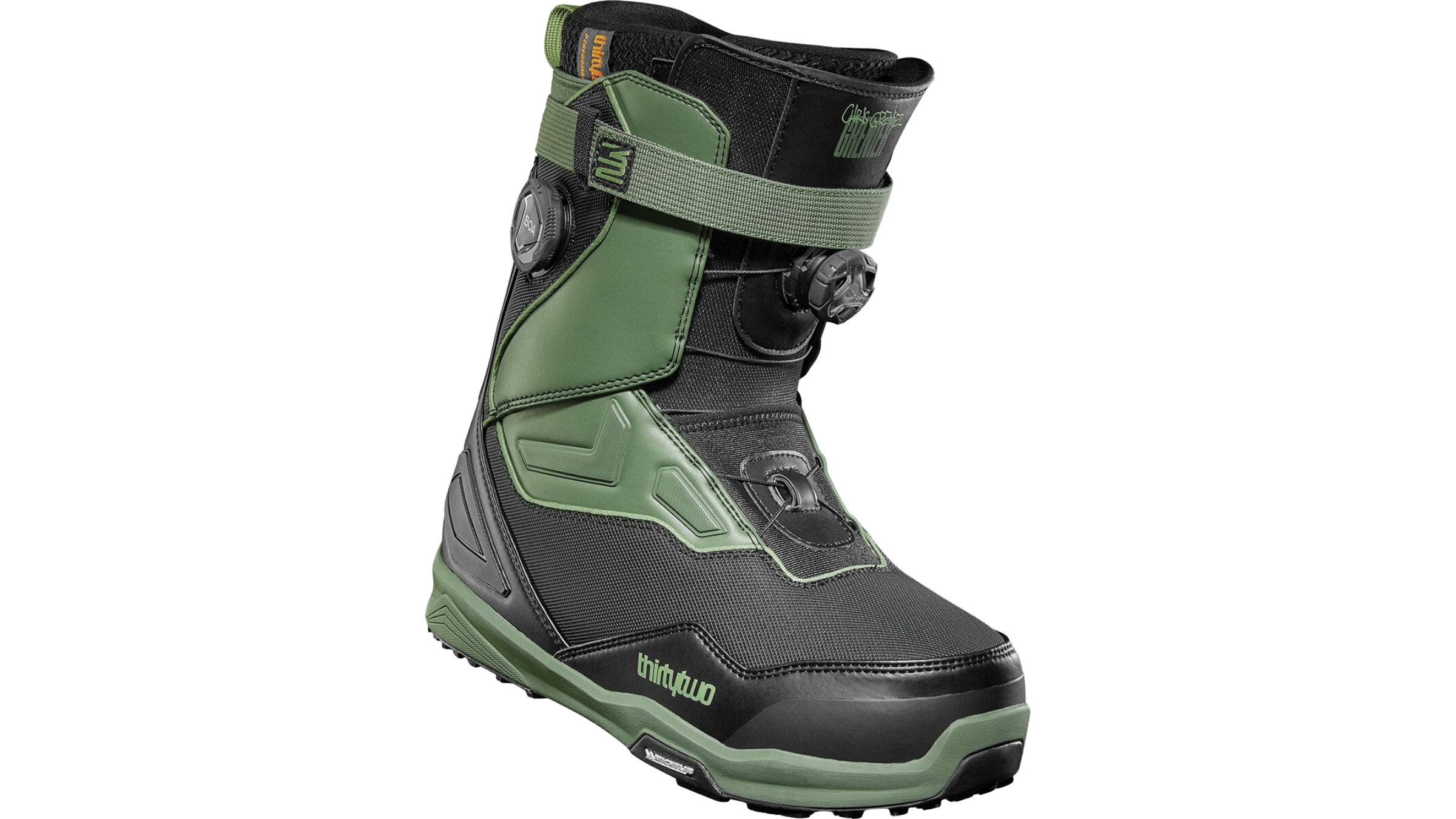
Paid Advertisement by Backcountry
ThirtyTwo TM-2 XLT Double Boa Grenier Boot
This stiff-flexing snowboard boot is ideal for both aggressive freeriding and all-mountain lines. The Dual BOA Fit System delivers secure, micro-adjustable lockdown on both the calf and the top of the foot, giving you a customized fit during every ride. The Michelin Fiberlite outsole also offers lightweight traction in harsh terrain and the elite liner features heat-moldable Intuition foam and adaptive arch support for added comfort. Tongue Tension+ and the Performance Harness help to eliminate heel lift and boost your control so you can carve as hard as you want without worrying about coming out of your boots. The Evolution Foam cushioning absorbs impact and keeps rebound high while the articulated cuff and molded tongue provide smooth, even flex without compromising on stability.
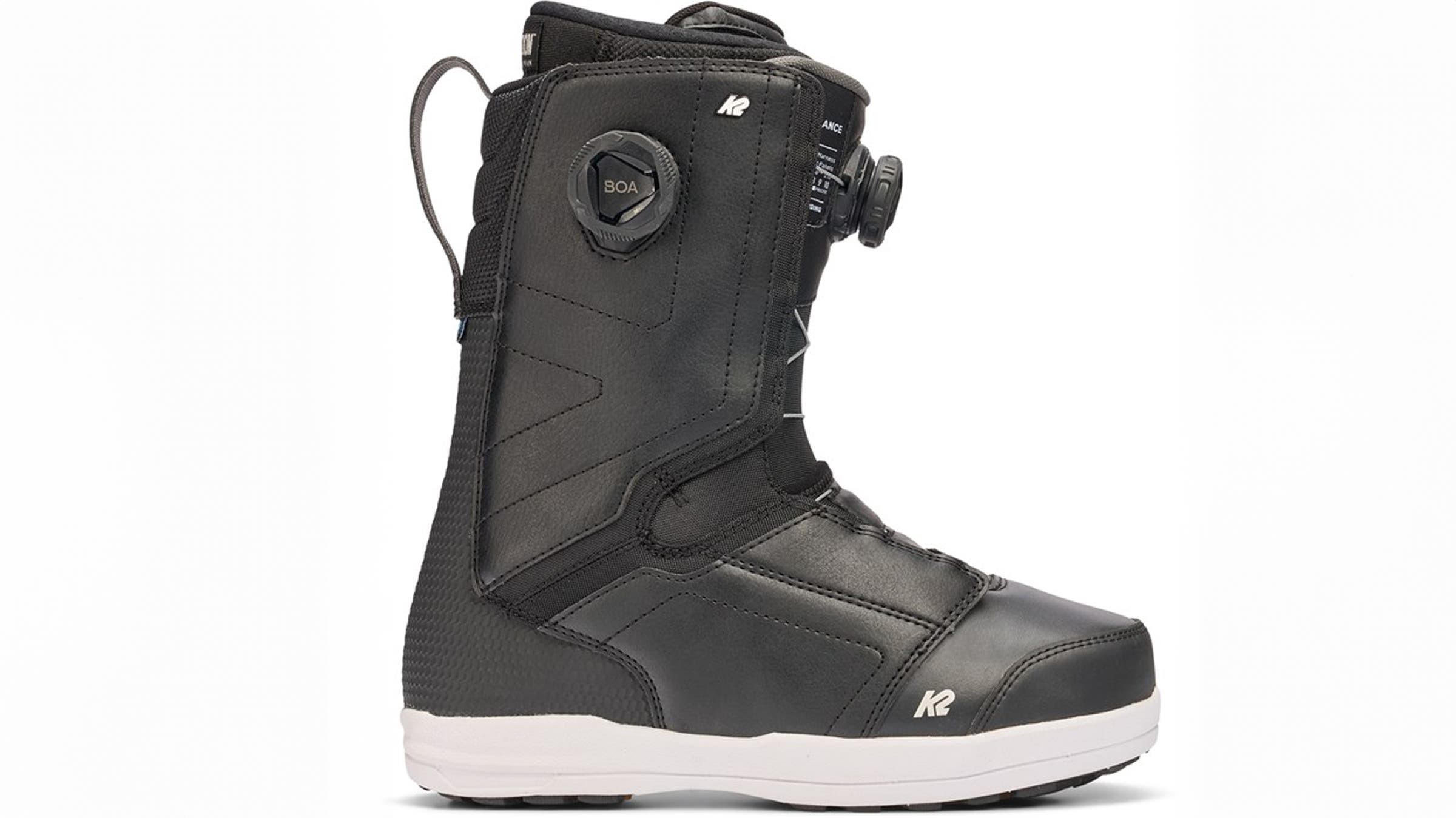
Best All-Mountain/Freeride Women’s Boot
K2 Trance
Sizes: 5-11 (women’s)
Pros and Cons
+ Enough backbone for hard-charging
+ Versatile enough for all-mountain use
+ Comfortable and secure fit
– Sloped toe caused some cap-style binding straps to slide off
One of K2’s stiffest women’s offerings, the Trance features a mid-firm backstay that speaks to all-mountain and freeride-focused rippers. “There’s plenty of stability for freeriding, but enough flex for cruising on a pow day, too,” said a Tahoe all-mountain tester, who gave the Trance a Goldilocks flex rating: “Not too stiff, not too flexible—a great middle ground.”
We were major fans of the heat moldable and multi-density Intuition Control foam liner, as well as three-point liner lacing harness that locks it in place. One BOA dial controls the upper half of the boot, and another tightens the lower, while an articulating cuff allows the two halves of the boot to flex independently of each other. The result? “No blisters or heel lift—my foot fits nicely, snug but not squished,” our tester said, which is especially high praise coming from someone with chronic ankle pain.
Another Tahoe rider with a wider foot agreed: “The BOA stays tight, with no pinch points, rubbing, or foot sleepiness.” She dug the lugged rubber outsole’s superior traction. However, we had one concern: Due to the sloped shape of the toe, certain binding straps designed to fit over the toe cap would slip off, no matter how much one tester tightened them.
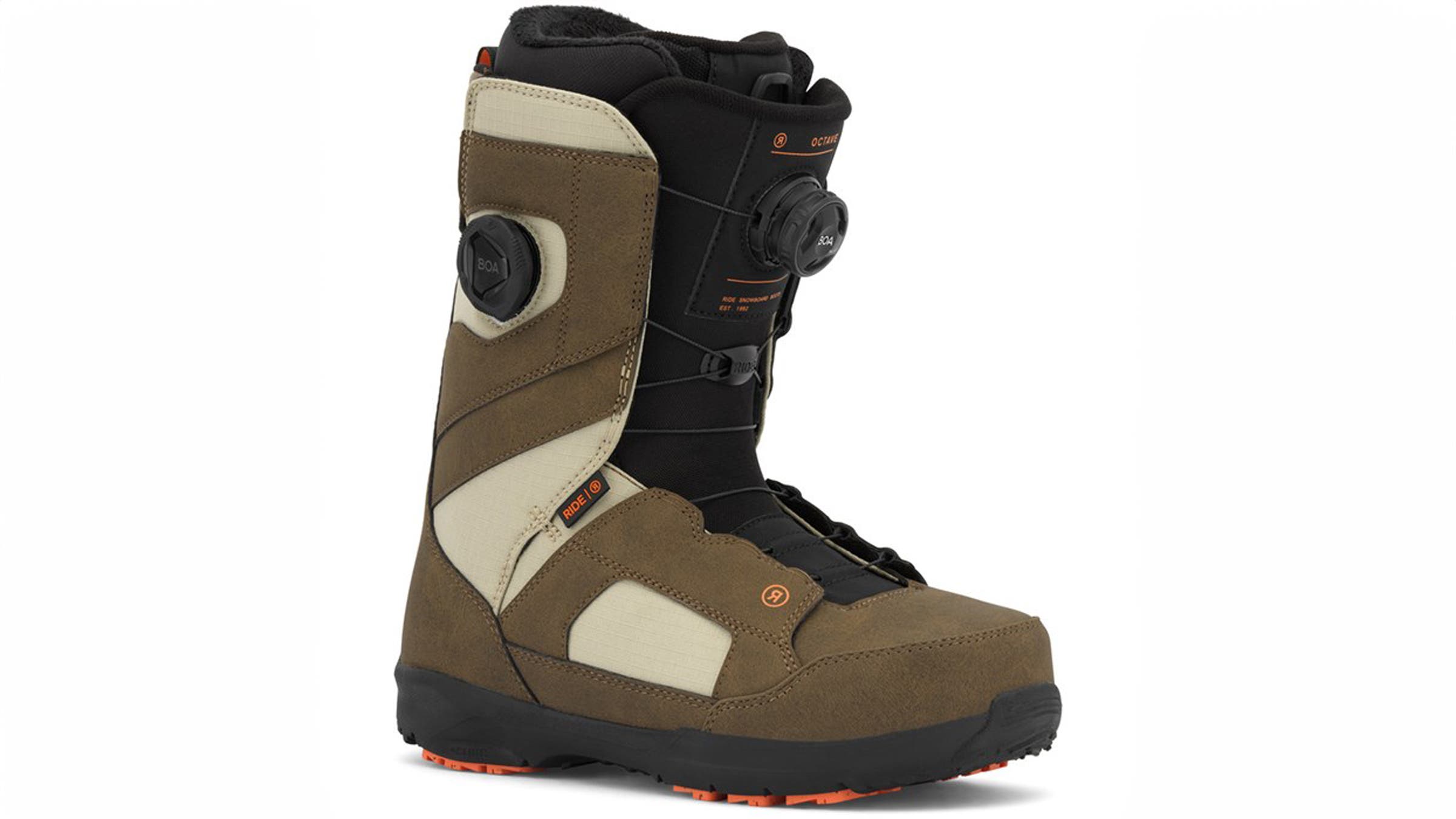
Most Comfortable All-Mountain Men’s Boot
Ride Octave
Sizes: 7-15 (men’s)
Pros and Cons
+ Fun and flexy
+ Big size run
+ Comfy and secure
+ Intermediate- and freestyle-friendly
– Not the best traction
Ride’s Octave is low-profile, comfy, lightweight, affordable, and no-frills, with an easy-riding, pliable medium flex that inspires playful all-mountain riding. Translation? It crushes in the park, and it can hang on powder days and freeride laps as well.
“All-terrain vehicle of a boot—versatility at its finest. It’s a workhorse,” reported a Wasatch tester after top-to-bottom laps at Kirkwood that started with cat track hits, mach-10 groomer descents, and cliff drops before ending in the terrain park. For riders seeking do-it-all performance without breaking the bank, it’s among the best snowboard boots in its price range.
He praised the high-density Intuition foam liner and the no-stress double BOA lacing system, calling the fit “comfy and trustworthy right out of the box.” The cuff has plenty of lateral give for butters, enough fore-aft support to euro carve and bomb fall lines, and, he reported, was slim enough to fit under skinnier pants. The midsole absorbs landings well, too. His biggest and only real complaint? The tread didn’t inspire confidence in icy parking lots or techy boot packs.
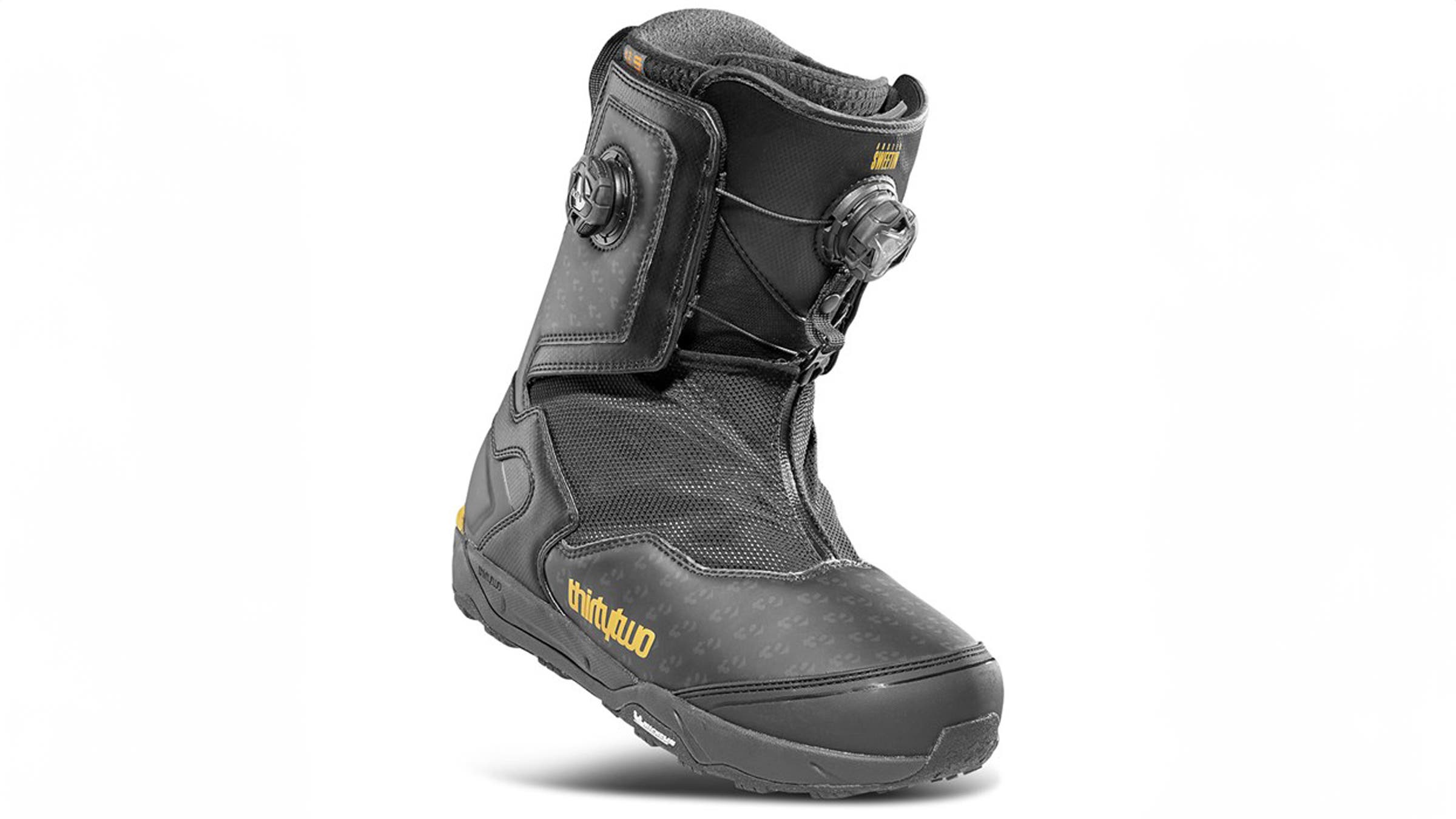
Best Snowboard Boot For Resort And Backcountry
ThirtyTwo Men’s Focus BOA x Sweetin
Sizes: 6-11.5 (men’s)
Pros and Cons
+ Responsive charger
+ Removable flex stiffeners
+ Top-tier outsole with crampon-compatible heel welt
– No walk mode for splitboarding
– Pricey
Austen Sweetin’s pro model boot shares much of the same tech as the ThirtyTwo Jones MTB Lite, our favorite splitboard boot. Namely, a relatively slim Michelin Fiberlite rubber outsole that’s stiffened by a responsive carbon shank and outfitted with a heel welt for semi-auto crampon compatibility. “Born to scramble,” said a Tahoe tester who claimed the molded toe cap “kicked steps like a soldier.” The zippered gaiter, another borrowed feature from the Jones splitboard line, helps protect against powder when bootpacking, too.
The Sweetin Focus BOA is not a split-specific boot, however, and it doesn’t have a true walk-mode, which “dedicated skintrack regulars will miss,” according to that tester. Additionally, it relies exclusively on BOA lacing—not our favorite for bigger missions and multi-day trips, as field repairs are a nightmare. However, pop the upper BOA dial to loosen it for some skintrack mobility, and the Sweetin is a capable climber that prioritizes downhill performance. “If you travel frequently or just want one boot to do it all, this is hard to beat,” one tester said
A stout overall construction and dual-density liner that’s bolstered by removable, stiffening inserts facilitates “direct response on any turn initiation,” according to another Tahoe tester who put the Sweetin to the test in the Sierra this spring. He liked the Velcro wrap on the liner because it helped eliminate heel hold and recommended the boot for all-mountain riders and freeriders, claiming “couloirs and big, aggressive lines” are the Sweetin’s bread and butter.
Lastly, he gave the boot props for being “overbuilt” and exceptionally durable–attributes that backcountry-bound riders will appreciate. However, he found a space between liner and tongue at the upper calf detracted from some of the boot’s innate responsiveness. This issue also resulted in a lack of compatibility with closely cropped pant legs—meaning if you’re still rocking the Shaun White skinnies, keep looking.
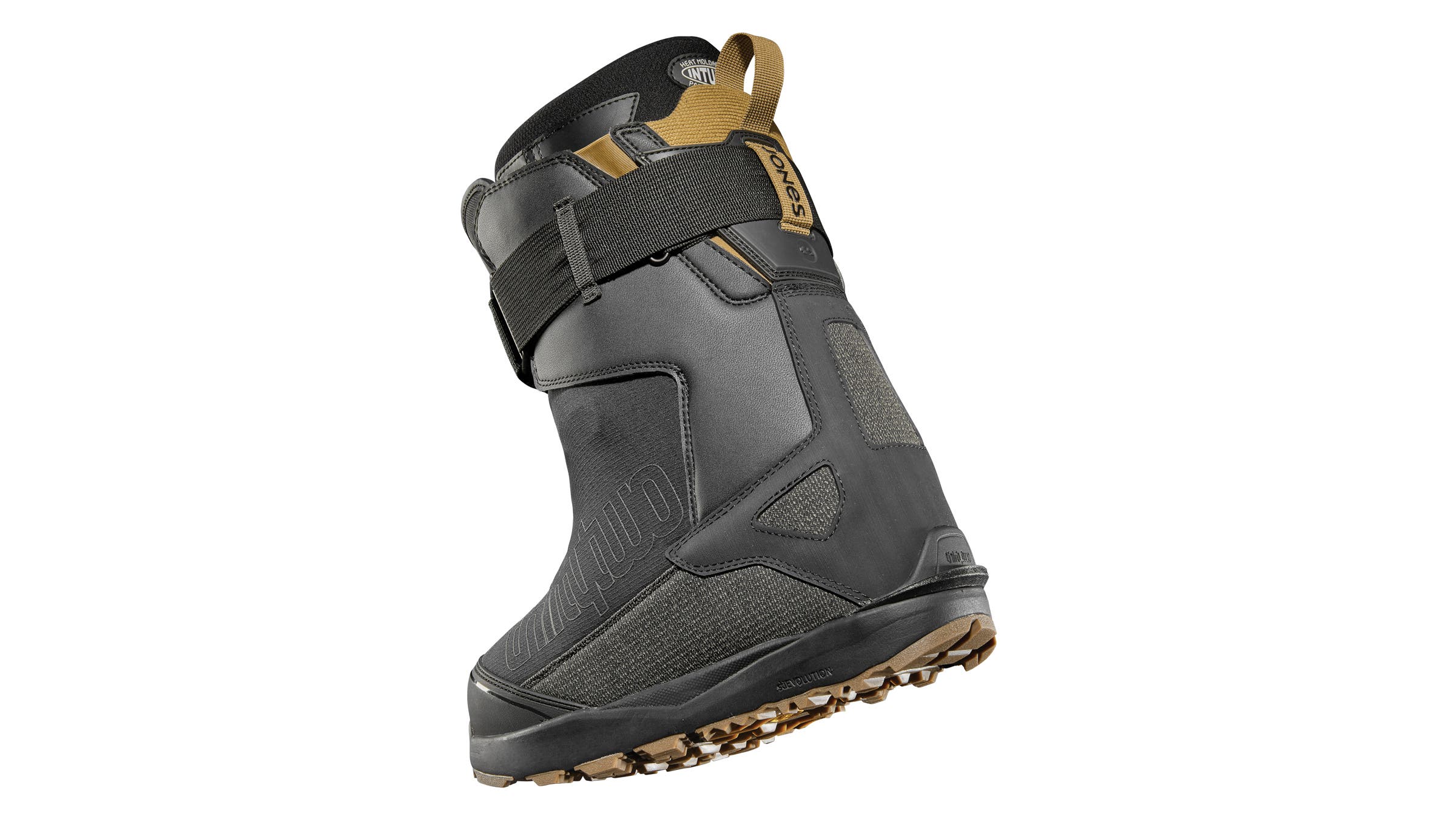
Best Approachable Splitboard Boot
ThirtyTwo TM-2 Jones
Sizes: 6-14 (men’s)
Pros and Cons
+ Crampon-compatible outsole
+ Excellent traction and bootpacking performance
+ Good walk mode
+ Happy medium flex
– Bulky
– Gaiter can cause overheating in spring
ThirtyTwo’s popular, all-mountain TM-2 ($285) is renowned for its versatility, beloved by pros and average Joes alike who want middle-of-the-park stiffness that can handle everything from the terrain park to the steeps. Jeremy Jones’ flagship pro model, the Jones MTB ($525), is a top-of-the-line splitboard specialist reserved for big mountain badasses: it’s an ultra-stiff boot with a reliable walk mode, a beefy, crampon-compatible, bootpack-slaying Vibram outsole, and a reinforced toe that kicks steps better in firm snow than virtually every splitboard softboot we’ve ever tried. Were the TM-2s and the MTBs to knock proverbial boots, the TM-2 Jones would be their love child.
While the Jones MTB maxes out ThirtyTwo’s stiffness scale, the TM-2 scores a more approachable, tweakable, and comfortable seven out of ten. The TM-2 Jones shares theTM-2’s all-mountain-ready flex pattern, making it much more suited for resort riding and gentle? touring. As a lighter, more playful rider, I don’t need 10 out of 10 stiffness, and the mellower yet still supportive flex of the TM-2 Jones is a happy medium for me. It’s responsive enough for high-speed freeriding in bounds or out, but there’s still enough play to integrate buttering and freestyle into your riding. Plus, it remains comfortable on long days in the skintrack.
Nevertheless, the MTB’s big mountain DNA is apparent—and welcome. The TM-2 Jones’ aggressively lugged Vibram outsole, crampon-compatible heel welt, and rubber-wrapped toe are identical to those on the stiffer MTB, allowing backcountry bootpackers to kick steps and scramble rocky ridges with confidence. After slick, sketchy scrambles in the Sierra, testers found the traction top-notch, and one, Tahoe shop tech Anthony Santos, pointed out that the Velcro power strap over the shin also provided “easy walk mode adjustment.” Santos reported the TM-2 Jones was “ready for whacky, off-board romping with pointy things.”
A downside: the outsole and wrapped toe add significant heft and bulk, compared to standard resort boots. Additionally, one tester reported the gaiter, which helps keep snow out on powder days, led to frustratingly sweaty feet on warmer corn missions.
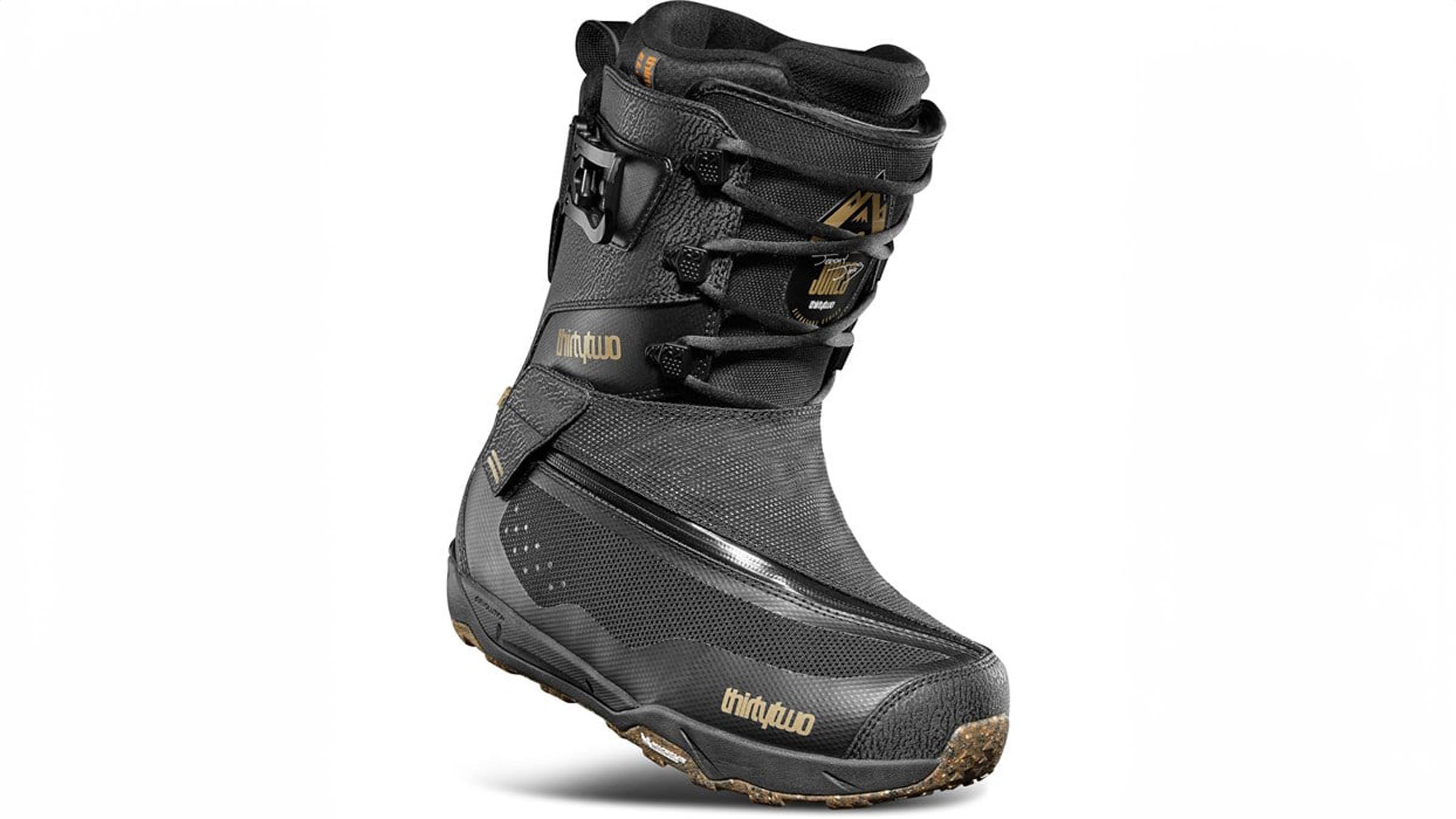
Best Splitboard Boot
ThirtyTwo Men’s Jeremy Jones MTB LITE
Sizes: 6-13 (men’s)
Pros and Cons
+ Excellent walk mode for a soft boot
+ Top-tier outsole with crampon-compatible heel welt
+ Responsive, stiff, and trustworthy on the descent
– Overkill for mellower splitters
– Some sizing issues
– Very pricey
A stout, step-kicking, boot-packing machine, the Jones MTB LITE—Jeremy Jones’ new pro splitboard model—features a beefy, molded toe-cap, a generously lugged Michelin Fiberlite rubber outsole, and a crampon-compatible heel welt. “Grippy. These outsoles are beastly in the bootpack, and I love the trustworthy crampon connection,” approved a Tahoe splitter.
That said, it’s the walk mode that makes the LITE one of the best options for softbooters on the market right now. A buckle-style clasp on the outer calf locks the boot in ride mode. Pop the buckle open, and a folded panel expands outward at the calf, giving splitters valuable skintrack range of motion. Our crew was also stoked to see ThirtyTwo move away from a dial-operated walk mode, too, which could be found on the MTB LITE’s predecessor. “I haven’t had any issues yet, but my initial impression is the buckle attachment seems much harder to break and easier to jerry-rig in a pinch,” said a tester.
When it’s time to transition, the MTB Lite is a stiff, responsive sender. Its removable stiffeners can be ditched for relatively surfier shredding or even saved for down the line to reinvigorate a clapped shell. “Trustworthy in tech terrain,” commented our Tahoe tester, although he recommended ThirtyTwo’s less aggressive TM-2 Jones for folks seeking more forgiveness. Another big mountain rider from the Wasatch loved the old-school laces combined with a comfy, high-quality liner, finding fit and heel hold on point. Some testers reported fit on the large size; consider sizing down.
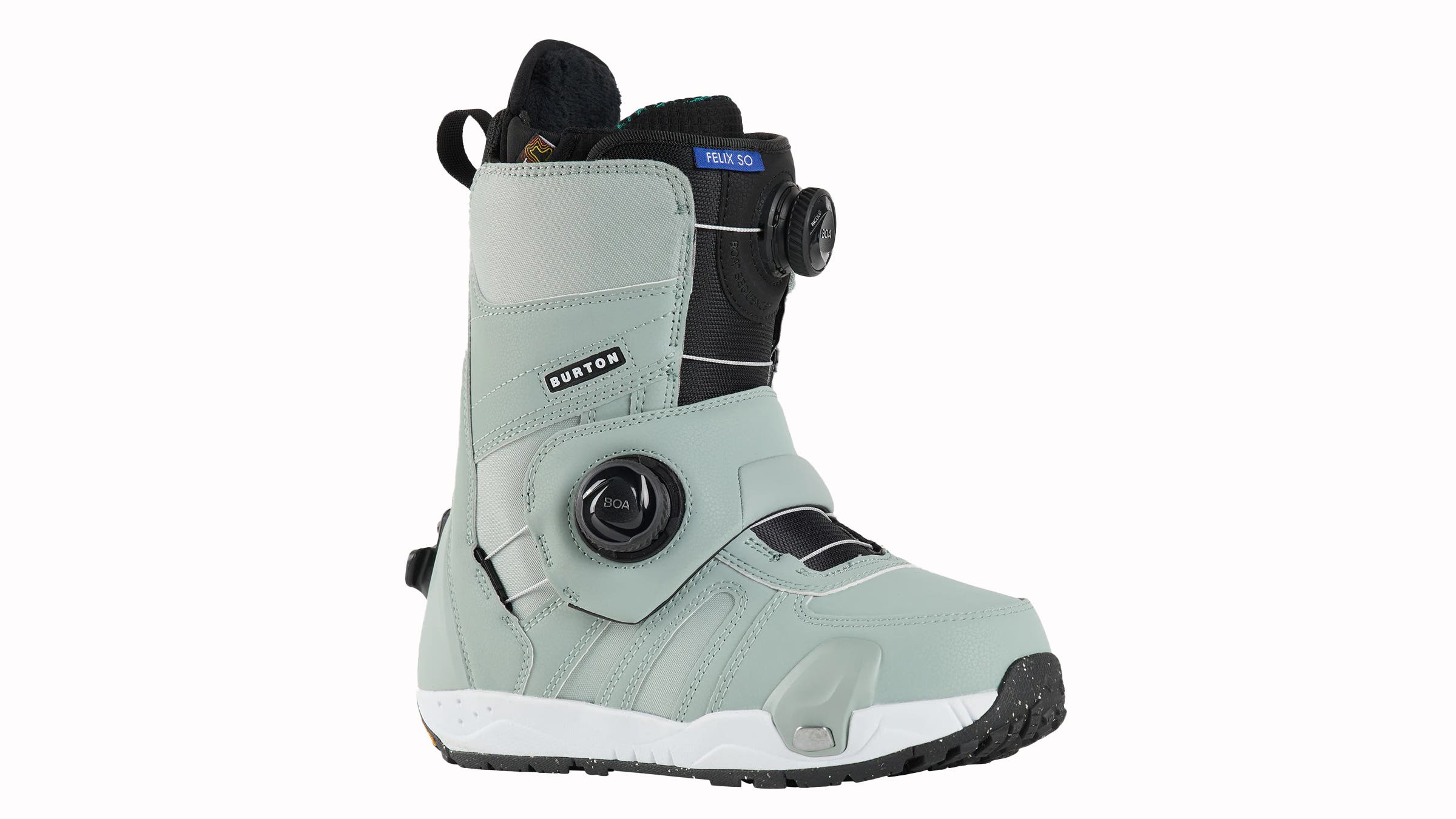
Best Step On Boots
Men’s Burton Photon/Women’s Burton Felix Step On Snowboard Boots
Sizing: 7-15 regular and wide (men’s Photon); 5-10 regular and wide (women’s Felix)
Pros and Cons
+ Balanced all-mountain flex
+ Solid heel hold and traction
+ Fast and easy binding entry in flat terrain
– Difficult to disengage in steep terrain
– Expensive
– You’ll need Step On bindings, too
Switching to a Step On setup can be pricey, as you need to invest in both boots and bindings simultaneously. Burton’s women’s Felix and men’s Photon are Burton’s upper-to-mid-tier options, offering Step On users a balance of comfy out-of-the-box fit and mid-range, capable, all-mountain flex without breaking the bank. Of course, 500-dollar boots are by no means affordable, but Burton’s top-shelf Step On options top out in the 700s.
What do you get for the price? “No heel lift or blisters,” said a cruisy Tahoe tester who scored the Felix highly for overall responsiveness. Testers gave the Vibram outsole props, too. “Great tread,” reported a rider accustomed to bootpacking for her turns.
We had our gripes, too: Multiple testers wanted a wider toe box and felt the main BOA dial that tightens the bulk of the boot doesn’t allow fine-tuning upper and
lower separately, which can be a dealbreaker for folks with finicky feet. The biggest issue, however, was simply the fact that most testers prefer standard boots to Step Ons. The system is easy to use in the flats, but less intuitive in freeride terrain. “I wasn’t able to take off my board after getting cliffed out because I was heelside in steep terrain,” grumbled a Tahoe snowboard coach, although he found that the Photons paired with the Cartel X bindings offered excellent responsiveness once locked in.
How to Choose the Best Snowboard Boots
Shopping for snowboard boots can be overwhelming. Here are five tried-and-true tips to make the process as smooth as possible.
Shop for Boots First: If possible, shop for snowboard boots before boards and bindings. Your boot size influences both your binding size and acceptable board widths. Some boots, like the Ride Hera and K2 Orton, have compact footprints, which means you’re less likely to have toe or heel drag on a narrower board. If you end up buying a boot with a bigger footprint, or you have a size 10.5 boot or higher, you may want to consider a mid-wide, wide, or volume-shifted board.
Stick to Brands You Know and Love: Every brand has a slightly different fit. Some are known for being wider or skinnier, or running bigger or smaller. If your last pair of boots fit well, consider repeating your experience with that specific brand, as chances are the fit hasn’t changed much over time. Many testers swear by the strategy of purchasing a newer version of the same boot model.
Invest in Insoles: Even high-end snowboard boots often sport garbage insoles (as reported by a tester who fits boots for a local shop), and one of the best ways to improve fit, comfort, and performance is with an aftermarket insole. We’re partial to Superfeet in most instances, but Remind Insoles aren’t a bad play if you’re looking for more shock absorption. If you really want to go the extra mile, get a custom pair from a bootfitter.
Put Your Faith in Bootfitters: There’s a misconception that only skiers need to get their boots fitted. Once you’ve had your snowboard boots professionally fit, however, you’ll never go back—especially if you have a history of foot pain. Ideally, schedule an appointment with a bootfitter who is also a snowboarder, as they’ll have a better idea of what problems you’ll face on the hill. Bootfitters can help you with everything from run-of-the-mill heat molding to boot punches, heel hold adjustments, liner replacements, and custom insoles.
Demos, Snowboard Shops, and Return Policies: Every foot is different, so it’s worth attending demos at your local hill, or demoing boots from local shops. When you do make a purchase, support your local snowboard shop if you can (especially if you demoed boots from them). If you prefer to shop online, buy from a reputable online retailer like REI or Backcountry that has a flexible return policy.
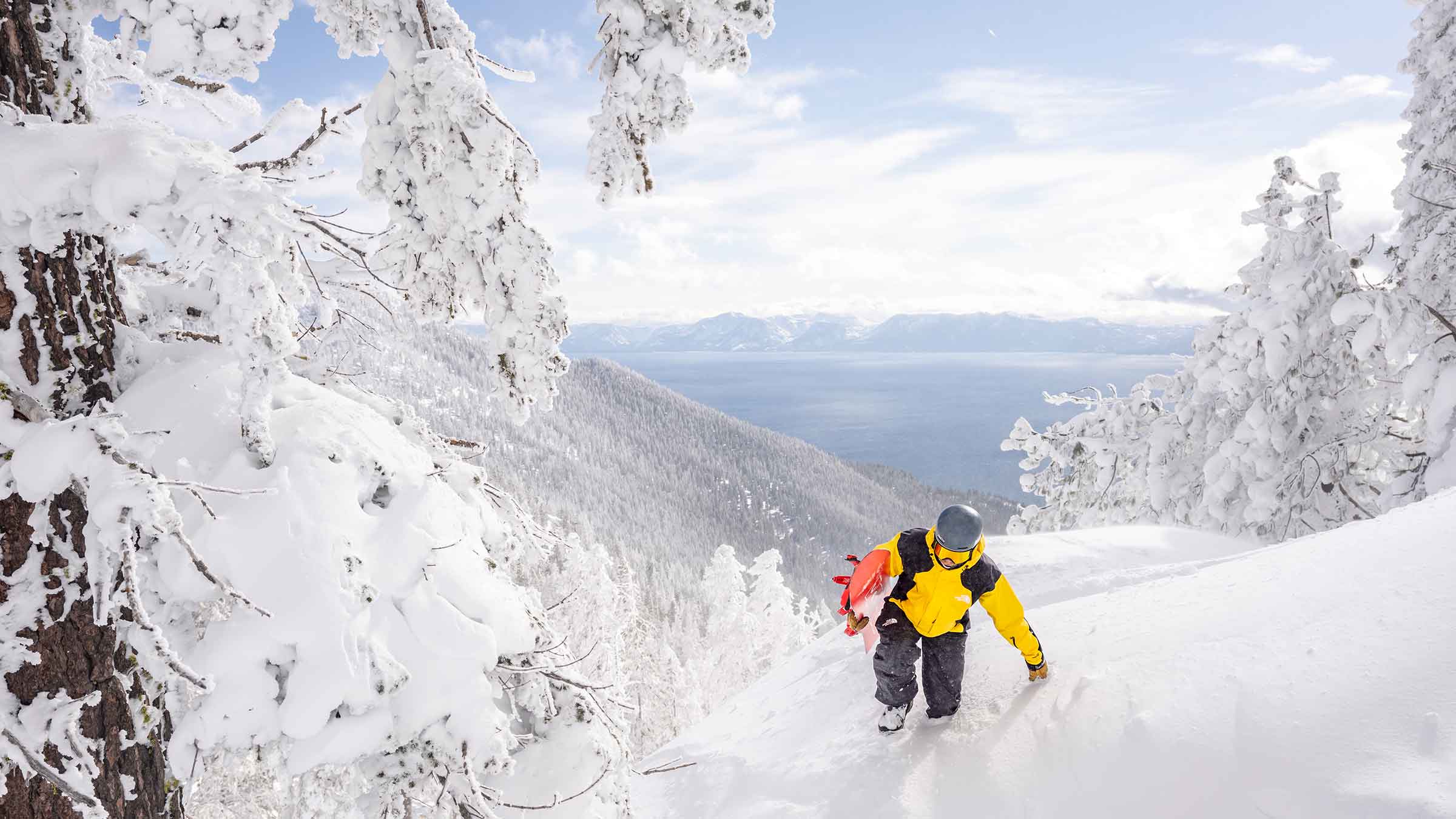
How We Test
- Number of boots tested: 24
- Number of testers: 30
- Biggest spin of the test: 720
- Tester-on-tester collisions: 1
- Cases of Fat Tire remaining at the end of the test: 0
Our boot testing starts at our annual snowboard test, which we held at Tahoe’s Kirkwood Mountain Resort this past season. A solid crew of mostly local snowboarders and splitboarders flocked to the test, where we collected boots from brands big and small. At the beginning of our test week, riders sifted through the boot pile, hunting for a pair that fit both their foot size and shape as well as their preferred style of riding (all-mountain, freestyle, freeride, etc.) and skill level (intermediate to expert). After getting a jump on testing at Kirkwood, we then sent those boots home with riders for long-term testing at their home mountains.
Long-term testing is crucial for picking the best snowboard boots, as break-in periods vary. A boot might be stellar out of the box, only to blow out in 10 days. Or, vice versa, a boot might be stiff, uncomfortable, and difficult to break in for the first week, then turn into our favorite boot once it’s been out on the hill for a spell. Additionally, we encouraged testers to swap out insoles and get boots heat-molded and professionally fit—whatever they would normally do if purchasing a new pair of boots.
Once chairlifts stopped cranking and splitboarders hung up their skins for the season, we asked our test crew to fill out review forms. These forms score boots quantitatively on aspects like responsiveness, comfort, lacing systems, as well as forward and lateral flex. The testers then dove deep into qualitative responses, answering questions like: Would you purchase these boots? What rider would like these boots? Are the boots bulky or low-profile? What are your impressions on the inner and outer lacing systems?
Finally, I—test director Drew Zieff—sifted through the review forms to determine the best snowboard boots and write these reviews.
Meet Our Testers
Drew Zieff is a Tahoe-based freelance writer and a lifelong snowboarder. Burdened with unnaturally long second toes and skinny calves and ankles, Zieff is no stranger to the boot-fitting chair (he’s a regular at Tahoe SportsHub), and he generally doesn’t trust stock insoles any more than he’ll sniff rental ones. In addition to directing Outside’s snowboard test, a role he’s handled since 2016, he directs Backcountry Magazine’s splitboard coverage and nerds out on snowboard gear and travel for Whitelines Snowboarding, REI, Gear Junkie, among others. He spends his winters testing gear in his backyard backcountry zones or up at Palisades when he’s not chasing stories and storms around the globe.
In a word, Kordell Black is a character. An esoteric ripper and veteran gear tester based in the Wasatch, Black has traveled the world with his splitboard in pursuit of powder and off-the-beaten-track adventures. He approaches big mountain lines with creative, freestyle energy, specializes in finding powder stashes overlooked by the Utah crowds, and thrashes boots into oblivion in a matter of weeks. He will also obliterate you in a flat ground game of SKATE.
Truckee’s own Jenna Shlachter is as brilliant on the hill as she is off it—which is saying something since she’s a Doctor of Psychology, after all. When she’s not on the clock, she’s usually on her snowboard, ripping everything from park to powder. Her trophy shelf needs regular reinforcement, as every year she seems to add banked slalom awards to her already impressive collection. Lucky for us, Shlachter is also an unabashed snowboard nerd, and she’s been a key contributor to our snowboard test for the last few seasons.


